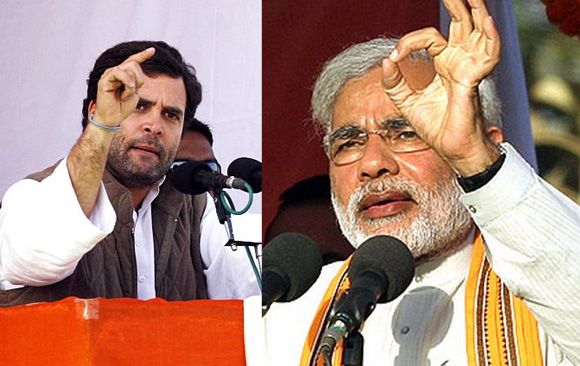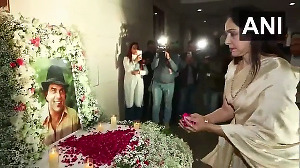 A Narendra Modi administration would believe more in decentralisation than would a Rahul Gandhi administration, says Arvind Panagariya.
A Narendra Modi administration would believe more in decentralisation than would a Rahul Gandhi administration, says Arvind Panagariya.
Both the Congress and the Bharatiya Janata Party manifestos are now out. They, along with the speeches by leaders of the two parties, provide the basis for the comparison of likely administrations under them.
There is agreement between the two sides on objectives: both would like to rapidly end poverty, illiteracy and ill-health and modernise India. But the preferred policy instruments markedly differ.
The BJP manifesto largely reflects the view articulated by Narendra Modi in his numerous speeches in the last two months. He argues that growth and social spending it makes possible are for all citizens and actively opposes discrimination based on religion citing the Constitution. Therefore, he is likely to rely first and foremost on growth and development to eradicate poverty, illiteracy and ill-health.
Modi firmly believes in building highways, railways, cities and universities to modernise India and to create jobs that would empower people to access housing, education and health. In assessing schools for recognition, he emphasises performance outcomes instead of input norms. In the provision of health, he gives wellness priority over illness and hence seeks enhanced public health measures.
This vision, reflected in the BJP manifesto, has its roots in Modi's Gujarat experience. During the last 12 years, he has pursued growth-oriented policies in his home state. These policies are not centred on just industry, as is often alleged. Instead, agriculture and rural development have been an integral part of his strategy. The state has seen one of the highest growth rates in agriculture in the last 10 years.
Furthermore, Gujarat today boasts of some of the best infrastructure, including not just excellent roads, ports, and 24x7 electricity for nearly all villages but also urban marvels as the Sabarmati Riverfront Development Project, the Kankaria Lake Development Project and the Bus Rapid Transit System in Ahmedabad, and the state-of-the-art solid waste management in Surat.
Alongside, poverty rates across all religions and social groups in Gujarat have come crashing down. Estimates based on the expenditure survey in 2011-12 by the National Sample Survey Office show that Gujarat now has the lowest rate of poverty among Muslims in rural areas. Equally significant, the overall poverty rate among Muslims in the state at 11.4 per cent is now significantly lower than the 17.6 per cent rate among Hindus.
Poverty among the Scheduled Castes has come down to 18.4 per cent compared with 17 per cent for all groups. Even for the Scheduled Tribes, which are numerous in Gujarat and suffer from the highest incidence of poverty, per cent point gain in poverty reduction between 2004-05 and 2011-12 has been larger than that for all groups. Growth has, thus, helped lift all boats.
Though much maligned for poor performance in social indicators, Gujarat has made above-average progress in cutting illiteracy and infant mortality as well as raising life expectancy. Among the large states, its gain of 10.2 percentage points in literacy between 2001 and 2011 is the highest except for Bihar, Uttar Pradesh and Odisha -- all of them have significantly lower levels of literacy. Its gains in cutting the proportion of underweight children since 2006-07 have been among the largest, according to the Integrated Child Development Services data. Rise in the female-male ratio at birth has also exceeded the national average during the 2000s.
In sharp contrast, the Congress manifesto goes for social spending as the principal instrument of combating poverty, illiteracy and ill-health. The manifesto proposes to take the rights approach to new heights. To the existing list of rights it enumerates -- right to information, education, food, employment, identity, fight against corruption, and direct receipt of welfare benefits -- it adds the promise of delivering by 2019 the right to health, pension, housing, social security, humane working conditions and entrepreneurship.
Coming on top of these generalised rights are special programmes for every group that the manifesto can conceivably define according to economic, social, religious and demographic characteristics. The manifesto proposes special programmes for workers, farmers, Scheduled Castes, Scheduled Tribes and Other Backward Castes, religious minorities, children, youth, women, and the northeast region. It is as if every single boat in the vast ocean must be lifted individually without due recognition that lifting one boat could damage other boats in the vicinity.
While employment, infrastructure, industrialisation and urbanisation do get a mention in the Congress manifesto, they appear as afterthoughts. The manifesto seeks a growth rate of eight per cent, but principally as a means of boosting government expenditures. Even so, it fails to recognise that this growth will be hopelessly inadequate to generate the vast revenues necessary to finance the mega expansion of rights and special programmes and other expenditures envisaged.
Perhaps the most fundamental difference in governance we are likely to see between the Narendra Modi and Rahul Gandhi administrations is with respect to decentralisation of power. In the last decade, one-size-fits-all central schemes have proliferated in the health, education, agriculture, skill development, employment, urban development and rural infrastructure sectors. These schemes require states to contribute significant proportions of expenditures and have progressively shrunk their fiscal space while absorbing the states' scarce human resources.
Having been the victim of this "tyranny" of the central government during the last decade as the chief minister of Gujarat, Modi will likely help the states recover some of this lost fiscal space. He will perhaps redesign the schemes in ways that give states greater flexibility and arrest their future proliferation. In contrast, under a Gandhi administration, the "rights" will expand and so will the central schemes, further shrinking the states' fiscal space.
A Modi administration is also likely to give greater legislative flexibility to states in subject areas included in the concurrent list such as criminal and civil procedure codes, labour, bankruptcy, legal and medical professions, education, acquisition of property, factories and boilers. Under Gandhi, the legal grip of the Centre on the states will continue to tighten unabated. After all, the non-governmental organisations that are likely to drive his policy agenda love the single-window facility for pushing their favourite social agendas that centralisation offers.
The writer is a professor at Columbia University, New York











